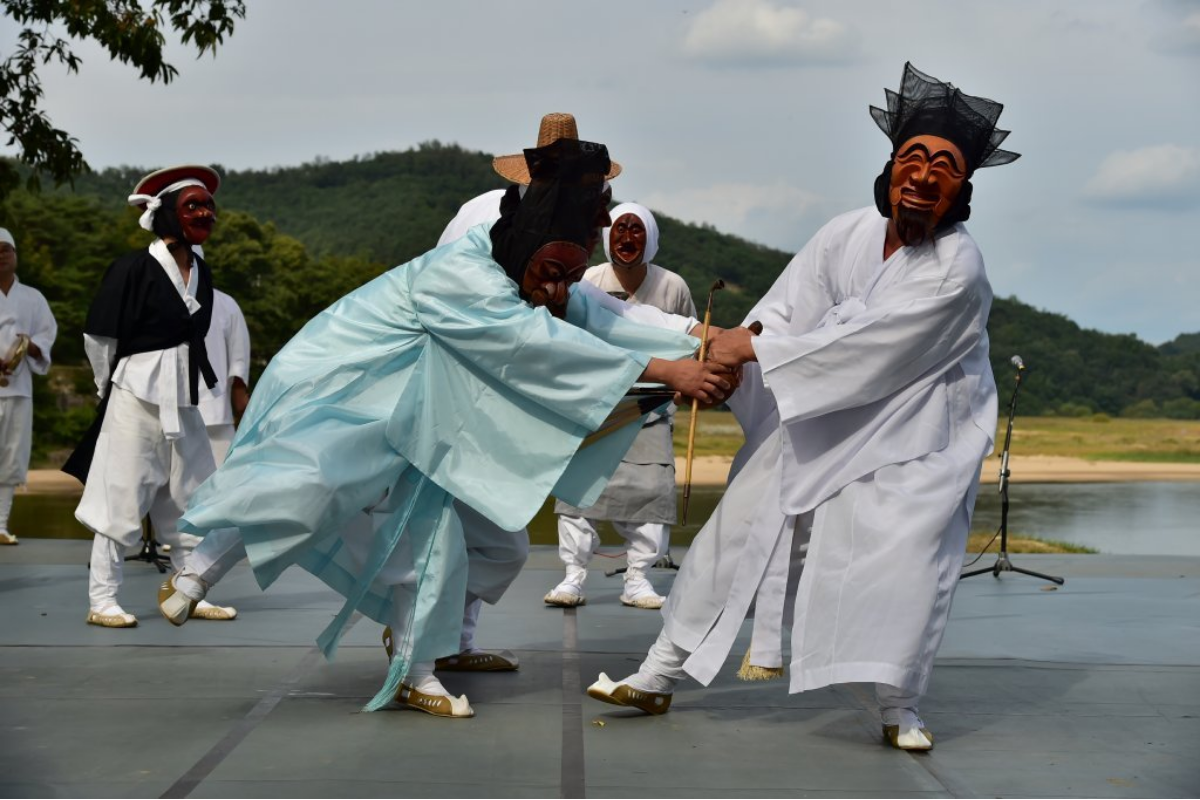Today, we're going to introduce you to Korea's unique and interesting talchum (탈춤) mask dance culture!
Let's find out how the talchum mask dance was used to express the feelings of Koreans in ancient times.
What Is Talchum?
 Source: blog.jinbo.net
Source: blog.jinbo.net
In Korean, talchum (탈춤) comes from the combination of 'tal' (탈), which means mask, and 'chum' (춤), which means dance, hence 'talchum'. Therefore, it is an art of wearing a mask while dancing, or mask dance for short.
The art of mask dance dates back to the period of the Three Kingdoms. Then, it began to spread and develop to its peak during the Joseon period. Nowadays, it is considered a long-standing part of folk culture and is performed in many areas throughout Korea.
The Evolution Of Talchum

The talchum mask dance is a form of folk entertainment. It is usually performed during festivals, such as New Year's Day, Mid-Autumn Festival, Dragon Boat Festival, Buddha's Birthday, etc.
However, behind all the entertainment and laughter it provides lie many thoughts and ideas that Koreans in ancient times wanted to convey.
 Source: doopedia
Source: doopedia
During the Three Kingdoms period, the mask dance was a simple ritual used to communicate with the gods. It was believed that the mask reflected the image of the gods, while the masked person could help convey the people's thoughts to the gods and vice versa. It was a fun form of communication between the gods and humans.
Later, in the Joseon era, the talchum mask dance was no longer a ritual for communicating with gods. Instead, it reflected the anger of the ordinary people towards the injustices faced under the noble class and feudal system.

During talchum, the performers stood in the middle and people gathered around to watch and cheer. The actors hid their identities behind masks, so they could dance and act as any character.
This allowed them to talk about various matters, including grievances that ordinary people would not dare to speak of normally.
There were a wide variety of issues mentioned, such as condemning the weakness of the king, criticizing the wickedness of society, mocking the hypocrisy of the aristocracy, questioning monks who ignored their precepts, etc.
 Source: News1
Source: News1
In the 1980s, mask dancing became widespread in Korean university districts. Now, it has become a folk performance that is full of unique culture that can be easily seen in the picture above.
For anyone who wants to watch the talchum mask dance once, you can visit Seoul Nori Madang (서울 놀이마당) to see it for yourself!
Features Of Talchum
1. Masks
 Source: hahoe.invil.org
Source: hahoe.invil.org
Each type of mask has different characteristics and materials depending on the region. The most commonly seen mask style is the Hahoetal (하회탈) mask. It originates from the Hahoe village and is made of alder wood.
It is unique in that the chin and rest of the mask are separated, so that dancers can move more easily during the performance.
There are 12 original Hahoetal masks representing different characters.
They are the 양반탈 (Yangban - aristocrat), 선비탈 (Seonbi - scholar), 중탈 (Jung - monk), 백정탈 (Baekjeong - butcher), 초랭이탈 (Choraengi - aristocrat's servant), 할미탈 (Halmi - old woman), 이매탈 (Imae - scholar's servant), 부네탈 (Bunae - concubine), 각시탈 (Gaksi - young woman/bride), 총각탈 (Chonggak - bachelor), 떡다리탈 (Ttukdari - old man), and 별채탈 (Byulchae - civil servant/tax collector).
Unfortunately, 3 of the masks have been lost: 총각탈 (Chonggak), 떡다리탈 (Ttukdari), and 별채탈 (Byulchae).
 Source: Naver
Source: Naver
Other styles of masks are the Okwangdae (오광대) and Yayu (야유) masks, which are large, simple, rough, and show stronger expressions..
The Bongsan mask (봉산) is a mask about the aristocracy and noblemen.
In addition, there is the Tongyeong (통영) mask based on the people's imagination. It often depicts the devil's face, so the mask showed an arrogant and mocking expression..
2. Characters
 Source: Kyongbuk Ilbo
Source: Kyongbuk Ilbo
Although the characters of the talchum mask dance differ from region to region, there are generally two types of popular characters: the protagonist who drives the main events in the story (주동인물) and the reactionary character who causes conflict with the main character (반동인물).
For example, the protagonist might be a nobleman and the reactionary characters might be the commoners.
The commoners attack the nobility with free speech and gestures and act very lively to increase the impact of the satire in the story and make it more interesting.
The characters in conflict with the main characters don't hesitate to speak and represent the thoughts of the audience. They use parody and profanity to condemn and criticize social problems.
3. Dance And Music
 Source: heritage.tv
Source: heritage.tv
Graceful dances and beautiful music make it more mesmerizing and contribute to the meaning. Most of the actors' words are spoken, but alternated with songs and exclamations to add some fun.
There are many different gestures involved in talchum that show the identity of different regions of Korea.

For example, in the Hahoe (하회) region, the mask dance involves religious ceremonies and worshipping the village gods. Each dance is a sacred ritual held to demonstrate the villagers' wishes of peace and happiness.
Some other regional mask dances, like the Yayu (야유) and Okwangdae (오광대) dances, no longer talk about holiness and gods, but are now a performance to criticize society for entertainment.
What do you think about Korea's unique talchum mask dance culture? Be sure to check out a folk performance like this during your next visit to Korea!

